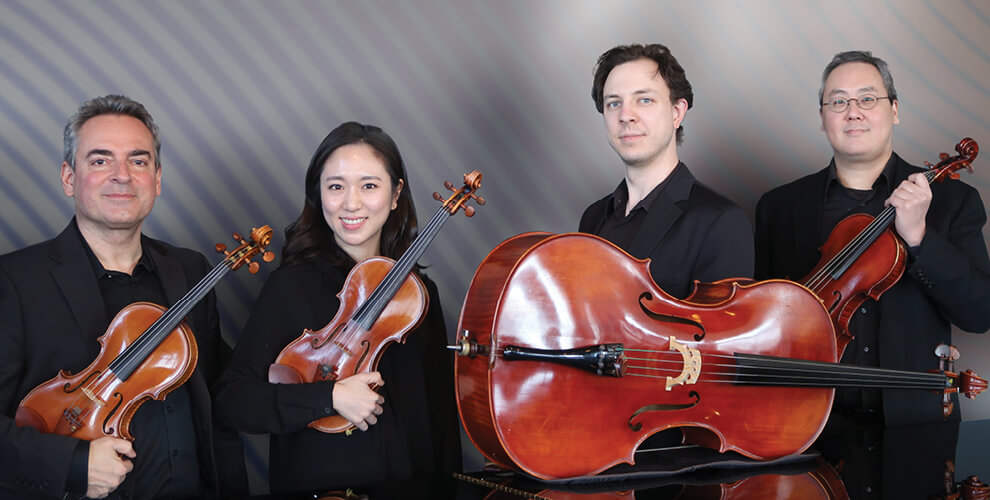Artists
Sujin Lim, violin
Marian Tănău, violin
Mike Chen, viola
Jeremy Crosmer, cello


Thursday, March 11, 2021, 2:00 p.m. EST
Online Event, Romanian Cultural Institute
The Romanian Cultural Institute’s popular online music series will feature one of the most important Romanian-American collaborative projects, the American Romanian Festival String Quartet (ARF Quartet), featuring: Sujin Lim – violin, Marian Tănău – violin, Mike Chen – viola, and Jeremy Crosmer – cello. The program features a rarely played piece, “On the River Argeș” by Theodor Grigoriu (1926–2014), an important composer and a musicologist in Romanian of the second half of the 20th century.
Watch on Romanian Cultural Institute’s FACEBOOK, YOUTUBE, INSTAGRAM and WEBSITE from Thursday, March 11, 2 p.m. EST or anytime later!
Sujin Lim, violin
Marian Tănău, violin
Mike Chen, viola
Jeremy Crosmer, cello
Theodor Grigoriu (1926–2014)
String Quartet “On the River Arges”
Ballade: Moderato poco rubato
Dance with flute
A la sorce: Lento soave
The small willow: Allegro molto
Theodor Grigoriu, composer
Theodor Grigoriu was born in 1926 in Galati, Romania. He studied at the Music Conservatory in Bucharest with composer Mihail Jora, who was a mentor to many Romanian composers. At the age of 17, Grigoriu received the prestigious “George Enescu” prize for a string quartet composition. In 1954, he traveled to Russia to study in Moscow with Aram Khachaturian.
His compositions include songs, choral works, cantatas, music for solo instruments, and orchestral music, as well as music for theater and film.
On the Argeș River (Pe Argeș în sus) is a string quartet composed in 1952. The work is in four movements and has a programmatic character. In this work, Grigoriu communicates the feelings roused by a walk alongside the upper part of the Argeș River in Romania. The title of the quartet quotes the first verse of a famous folk ballad about the building of the Curtea de Argeș Monastery, a famous architectural construction from the 16th century.
The composer uses original themes, as well as some folk tunes, from this region of Romania and creates a musical tapestry full of color, intricate harmonies, and simplicity.
The first movement, “Ballade” (“Balada”) is a fantasy that starts in a declamatory style. The theme is inspired by the folk story Ballad of Manole (Balada lui Manole). The introduction is followed by a fast section full of vivaciousness and complex and spirited rhythms. There are sounds imitating horns, which are reminiscent of Romania’s medieval past. The main theme of the first movement is the musical representation of the heroic acts of Manole and his team in raising the famous Monastery.
The second movement, “Whistle Dance” (“Joc din fluier”), is a quick scherzo evocative of a Romanian folk festival. It suggests happiness and fresh humor as might be felt by festival revelers who are dancing the hora. The string techniques employed emulate the sounds of the whistle.
The third movement, “At the Springs” (“La izvoare”), is meditative in nature. It is a series of variations expressing the walk along the river toward the spring, and conveying a reflective stop where the protagonist would rest to admire the river and nature.
The fourth movement, “Little Willow” (“Sălcioara”), is a rondo with the repeating theme of a folk dance by the same name. The middle part reintroduces and ties together the main idea of the entire work, the “Balada.” The movement ends with an energetic and fast finale.
Established in 1969 as the Romanian Library, the Romanian Cultural Institute (RCI) in North America is one of Romania’s oldest cultural diplomacy vehicles. The transformation from a library to a cultural center and, since 2004, a cultural institute has marked almost five decades of development and periodic reinvention.
Endowed with a versatile institutional identity, the RCI is at once a curator, promoter, producer of artistic and cultural events, resource center and learning hub, which act in synergy to showcase the diversity and vibrancy of Romanian artistic, cultural and academic scene and to galvanize the Romanian-American cultural relations at all levels. While based in New York City, the RCI aspires to a Pan-American presence as our projects cover the whole of the United States and major cultural centers in Canada.
The RCI also acts as the principle artistic agency for Romanian artists in the United States and beyond. A networking specialist, it works to establish thriving, ever-expanding partnerships among Romanian and American cultural organizations, public or independent.
The RCI in North America is placed under the common heading of The Romanian Cultural Institute (the Bucharest HQ) and Romania’s Ministry of Foreign Affairs and is part of the 18-strong network of similar organizations scattered on four continents that constitute the backbone of Romania’s efforts to promote culture and arts throughout the world.